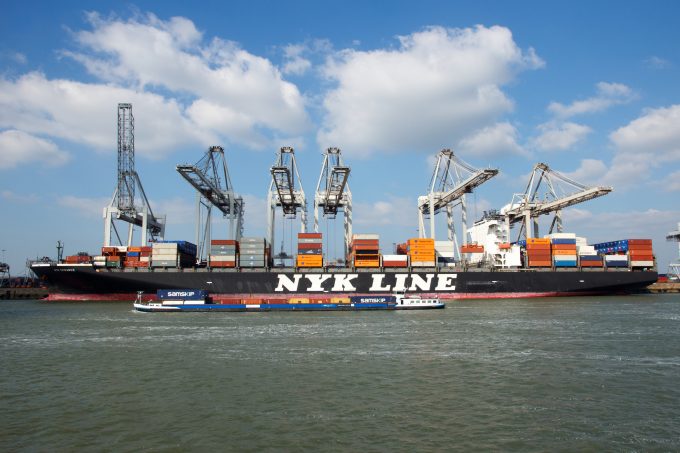Maersk expects profit hike on strong demand and Red Sea crisis
AP Møller-Maersk has raised its full-year earnings guidance amid “strong container market demand”. The Danish ...
GM: RAISING THE ROOF GGM: IN FULL THROTTLE GZIM: MAERSK BOOST KNIN: READ-ACROSSMAERSK: NOT ENOUGHMAERSK: GUIDANCE UPGRADEZIM: ROLLERCOASTERCAT: HEAVY DUTYMAERSK: CATCHING UP PG: DESTOCKING PATTERNSPG: HEALTH CHECKWTC: THE FALLGXO: DEFENSIVE FWRD: RALLYING ON TAKEOVER TALKODFL: STEADY YIELDVW: NEW MODEL NEEDEDWTC: TAKING PROFIT
GM: RAISING THE ROOF GGM: IN FULL THROTTLE GZIM: MAERSK BOOST KNIN: READ-ACROSSMAERSK: NOT ENOUGHMAERSK: GUIDANCE UPGRADEZIM: ROLLERCOASTERCAT: HEAVY DUTYMAERSK: CATCHING UP PG: DESTOCKING PATTERNSPG: HEALTH CHECKWTC: THE FALLGXO: DEFENSIVE FWRD: RALLYING ON TAKEOVER TALKODFL: STEADY YIELDVW: NEW MODEL NEEDEDWTC: TAKING PROFIT

Japanese shipping groups K Line, MOL and NYK have reported a generally improving trend in their container sectors for their nine-month fiscal period ending on 31 December.
NYK remained profitable and MOL turned in a breakeven performance, but K Line slipped back into the red in the third quarter.
This was the penultimate quarter before the merger of their container businesses into Ocean Network Express (ONE) on 1 April.
For the nine-month period, K Line recorded a ¥7bn ($62m) profit on its liner business, earned from a 20% uplift in revenue to ¥458bn, compared with a ¥24bn ($220m) loss in the same period the previous year.
However, the third quarter this year was clearly challenging, as the carrier slipped back into the red to the tune of ¥2bn, blaming “lower-than-expected” freight rates between Asia and North America and other services.
“Cargo movements in the east-west services remained firm in the containership business, but as the supply/demand balance did not improve, freight rates remained top heavy,” said K Line.
It said it handled around 14% more containers between Asia and Europe in the nine-month period as it transitioned from the disbanded CKYE alliance to THE Alliance grouping.
The carrier said “robust cargo movements” on its intra-Asia services resulted in a year-on-year 10% uplift in traffic, but on the transpacific Asia-US loops cargo grew but just 1%, and on north-south routes there was a 3% decline.
MOL did somewhat better in the third quarter with its liner performance improving from an accumulated deficit of Y4.1bn in the first half to a near-breakeven Y0.3bn loss at the end of the nine months.
MOL said that “demand continued to proceed firmly as cargo volumes from Asia reached a record high”, however it added that “even during the busy season” spot rate improvements “were limited” which it believed was due to “the deployment of new containerships”.
It said that increased demand for backhaul cargoes from Europe to Asia, resulting in a sustained spike in spot rates, had “greatly contributed to route profitability”.
“Under this business environment, and thanks also to the contribution from annual contract freight rates that have risen upon renewals since the start of the year, and efforts to cut operation costs by reducing the expenses of repositioning empty containers through improved yield management, the ordinary loss in the containership business was reduced year-on-year,” said MOL.
NYK, which will have a 38% stake in ONE, compared with the 31% each held by K Line and MOL, continued to improve its performance in liner trading, adding nearly ¥4bn to its container sector profit to reach a cumulative ¥17.2bn at the end of nine months.
It said the results “improved substantially”, which it attributed to “brisk” volumes on transpacific and Asia to Europe routes.
However, NYK also blamed “the impact of growing shipping capacity, caused by the production of new ultra-large containerships” as the cause of the “standstill” in the spot rate upswing.
The Japanese carrier trio say they expect to save $440m in the first year following the launch of ONE, and thereafter $1bn a year, from personnel consolidation, combining agencies and subsidiaries and achieving lowest-common-denominator reductions on port and service provider costs.
Comment on this article